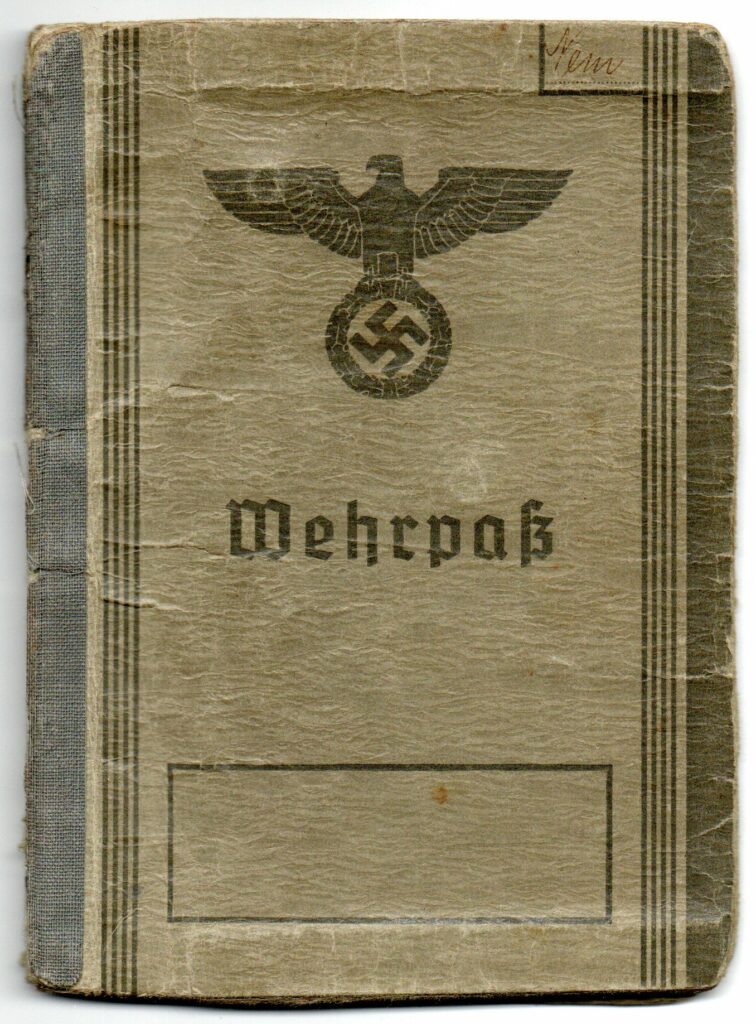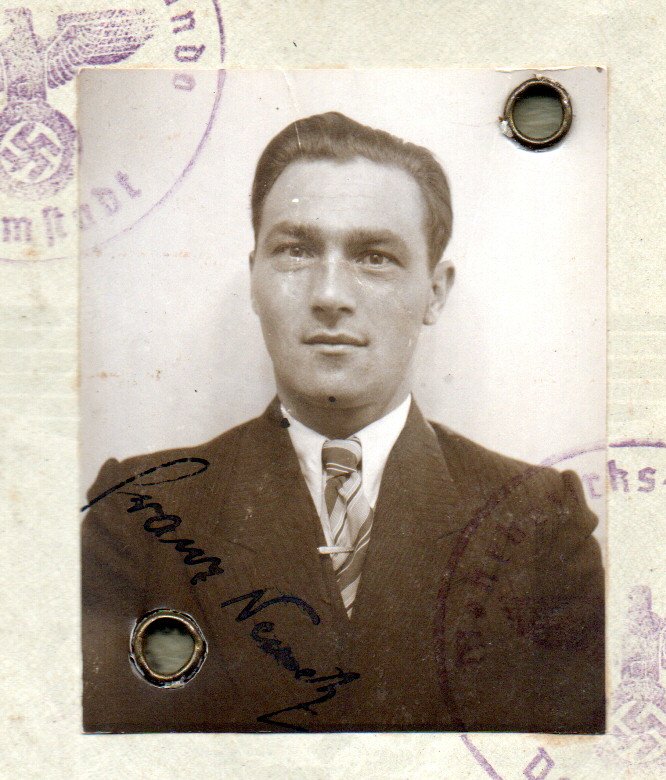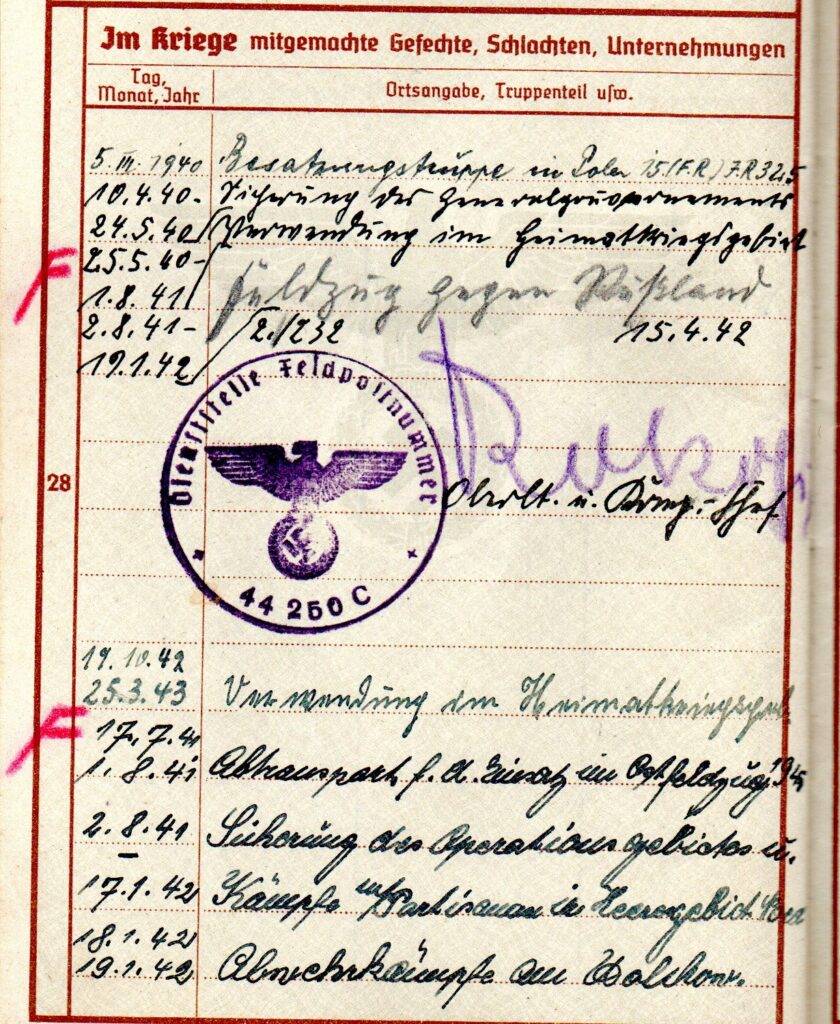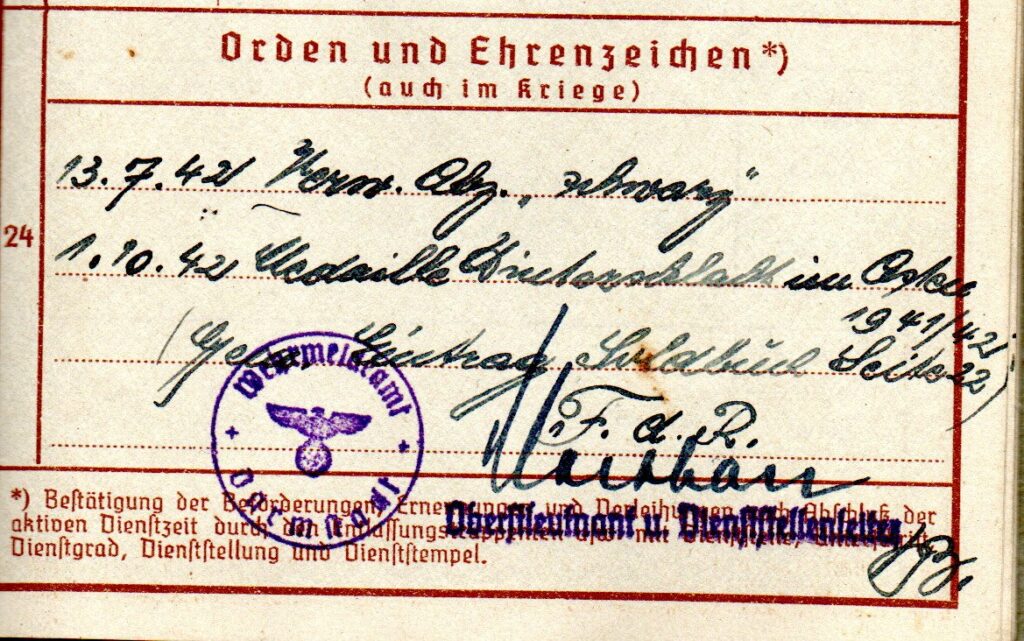“Bataillon Command Post, January 22, 1941.
From: Landesschützen-Bataillon 232
To: Landesschützen-Regiment 113, Regimental Headquarters
The Bataillon was loaded onto 26 trucks at 6:00 PM on January 17, 1942, with the assignment to report to the headquarters of the XXXVIII Armee Korps in Raglizy, 36 kilometers west of Nowgorod. We reached Raglizy at midnight. Five trucks had fallen out due to minor damages. These were repaired and these trucks followed on the next day. The Bataillon was attached to the 126 Infanterie-Division and was under the command of Infanterie-Regiment 422. We were to report to Ortskommandantur Podberjesje, 18 kilometers northeast of Nowgorod. We arrived in Podberjesje at 5:00 AM on January 18, 1942. The Division placed us under the command of the Regiment 424. Out of the trucks took place an operation against a detachment of Russians, that had crossed the Wolchow and advanced across the highway connecting Nowgorod, Tschudowo and Petersburg. The operation lasted until 7:00 PM. In this operation the Bataillon suffered two dead and one wounded. The Bataillon was under the command of Sturmbannführer and Major Garthe, whose Abteilung was composed of our Bataillon, a Kompanie of Pionier troops, and a detachment of the Waffen-SS. For the night, the 2. and 3. Kompanie were sheltered in Podberjesje and the 1. Kompanie in Weschki, 6 kilometers northwest of Podberjesje.
For January 19, 1942, Abteilung Garthe was deployed on both sides of the railroad running from Nowgorod to Tschudowo, in the area of the villages Andruju, Linow, Tjuitzy, and Kopzy, in a renewed operation against the Russians who had broken through. In the night from the 18th-19th January 1942, the 3. Kompanie of Bataillon 232 was pulled out, attached to the III. Bataillon of Infanterie-Regiment 424 and sent to Sapolje on the Wolchow. In this operation, the 1. and 2. Kompanie were deployed to the right and left of the railroad line. After a few hours, this operation had to be called off, as in the meantime the Russians had broken through in Kopzy. The Abteilung Garthe was deployed on the attack on the railroad in Kopzy and the forest south of Kopzy, with the Bataillon initially attacking the Kopzy highway and then connecting through a total left turn with Kopzy and the bush terrain to the east. In the late afternoon, Kopzy was taken with the cooperation of an Aufklärungs-Abteilung deployed north of Kopzy, and tanks. On this day, the Bataillon lost 2 dead and 10 wounded. For the night, the Bataillon was quartered in Tjutizy and occupied the terrain east of the highway connecting Tjutizy and Kopzy. The night and following day passed without major attacks.
The 2. Kompanie was transferred to Kopzy on the evening of January 20, 1942. In the course of that day, the Bataillon moved into a defensive position in the aforementioned line. In the night of January 20th-21st, there was an attack by the Russians against this defensive position, and against the neighboring sector in Kopzy, in the strength of multiple Kompanien. This attack was preceded by heavy artillery and mortar fire on Kopzy, and weaker fire on Tjutizy. The attack was totally defeated by the Bataillon. In front of the 1. Kompanie, the enemy left behind around 30 dead. In front of the 2. Kompanie, as a result of the favorable terrain, the enemy was able to retrieve their dead. In Kopzy, the enemy broke through once again, but after lengthy battles they were thrown back into the night.
On January 20, 1942, at 10:00 AM, by order of the Regiment, the 1. Kompanie sent a scout troop in the strength of 21 men against the point 37.0, 2-1/2 kilometers from the northern edge of Tjutizy. Heavy machine gun fire from multiple sides prevented the scout troop from penetrating the forest. In the treeline, strong enemy forces in the strength of at least 4 to 5 platoons were moving. The Regimental commander personally recognized the scout troop leader, Feldwebel Schötzau, 1./232, for the well-led scout troop operation.
January 21 was again relatively quiet, although the enemy hit the villages of Kopzy and Tjutizy as well as the highway with heavy artillery, mortar ind infantry gun fire. Movements of the enemy in the forest east of the highway concluded in a renewed attack in the night of January 22, 1942. Starting at midnight, the enemy attacked the main battle line multiple times, above all in the northern sector. The attacks, which continued until dawn, were again repulsed. Around 4:00 AM individual Russian detachments began to evade the watch posts of the Pionier-Kompanie on the rightmost sector of Abteilung Garthe, to join the attack on Tjutizy. After lengthy battles the enemy was here, too, forced back. The enemy’s forward machine guns now covered the entire highway between Tjutizy and Kopzy, which also lay under heavy artillery and mortar fire. In the night of the 21st-22nd January, we lost one dead and eight wounded.
The total losses of the Bataillon from the 18th to the 22nd of January 1942 were 5 dead, 24 wounded. As a result of the extreme cold, frostbite was very common, as the Bataillon was lying in open positions in the snow, and almost routinely a large part of the Bataillon if not the entire unit was in the positions at night. So far, the Bataillon has lost 23 men to frostbite alone.
The fighting strength of the Bataillon has thereby been reduced considerably. The current fighting strength is as follows:
1. Kompanie: 1 officer, 15 NCOs, 65 enlisted men
2. Kompanie: 1 officer, 11 NCOs, 69 enlisted men
Those numbers do not include the losses of the 3. Kompanie. According to the reports received so far, the 3. Kompanie has lost one man to wounds. Larger battles are said to have been underway there since the night of 21st-22nd January. The Kompanie has lost 6 men to illness and one to frostbite.
Signed, Dr. Happel
Hauptmann and Bataillon leader
Losses and departures through January 23 in the 1. and 2. Kompanie:
6 dead, 29 wounded, 36 frostbite, 23 illness. Total 94 men.”
This Wehrpass belonged to Franz Nemetz.

Nemetz was born on March 24, 1912. He was Austrian, from Mitterndorf. He was trained a butcher, but worked as a truck driver.

In November 1939, when this Wehrpass was issued, Nemetz was 27, and single. During the war, he married his wife Minna. He was drafted into the German Army in March, 1940, and sent immediately to occupied Poland. After a little more than one month of training, he was assigned to 2. Kompanie, Infanterie-Regiment 325. He remained in Poland on occupation duty until the end of May, 1940, when he was sent back to Germany. There, his unit was used as a Wachbataillon, for guard duty. In this period Nemetz was promoted to Oberschütze and then to the rank of Gefreiter. On January 1, 1941, his unit was redesignated as Landesschützen-Bataillon 232. This unit was located in the area of Sandbostel and was tasked with guarding prisoners of war. On July 15, 1941, Nemetz’s unit was attached to the 285. Sicherungs-Division.

Preparations to send this unit to Russia began immediately. Nemetz’s journey East began on July 17, and by August 2 his unit had arrived in their quarters in the rear area of the northern sector of the Russian Front. His Wehrpass records that from August 2, 1941, to January 17, he took part in securing the operational area and in combat against partisans as part of 2. Kompanie, Landesschützen-Bataillon 232.

At 6 PM on January 17, Nemetz was one of the men on those trucks, headed to Raglizy. Probably, he was one of the drivers. Could he have known, when he left, that he would be driving almost directly into combat, he and his men facing Red Army Infantry as soon as they got off the trucks? His Wehrpass lists the fighting he participated in on the Wolchow as defensive actions. He was one of the ten men of the Bataillon wounded on January 18. The nature of this wound was not recorded in the Wehrpass but it was severe enough to land him in a convalescent unit for the next eight months.
The Wehrpass provides some detail about Nemetz’s military career. His primary role was as a truck driver, and was also trained as a machine gunner. He was trained on the G98 rifle and MG34 machine gun, and later, also on the MG 26 (t) (Czech ZB 26) and MG 08/15. These foreign and obsolete machine guns were typical of the weapons used by rear area units. For his actions in the winter of 1941 and his wounding in action with Abteilung Garthe, he was awarded the “Winterschlacht im Osten 1941/42” campaign medal, and a Wound Badge in Black.


In late September 1942, eight months after being wounded, Nemetz was given a physical and deemed to be fit for garrison duties in the homeland only. He would be reassigned to Landesschützen-Bataillon 213 in Tilsit, once again guarding prisoners of war, this time at a subcamp of Stalag 1A Stablack.
For the members of Landesschützen-Bataillon 232 who made it through the fighting around Kopzy without being killed, wounded, or frostbitten, more combat awaited them. In 1942 this unit was redesignated Sicherungs-Bataillon 232. They remained in Russia until the unit was essentially destroyed and disbanded in 1944.